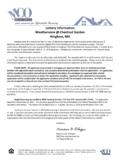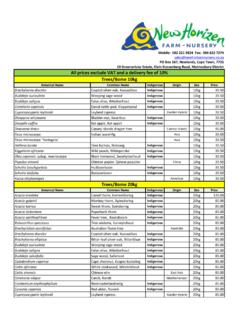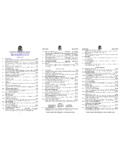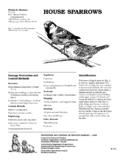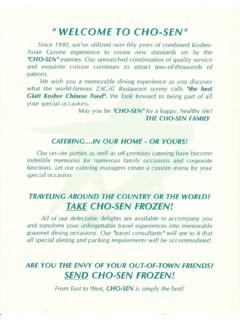Transcription of Chestnut Growers Guide to Pests and Diseases
1 | The JournAl oF The AmeriCAn Chestnut FoundATion 17 Growing American chestnuts is an adventure with many rewards: stately trees, delicious nuts, and conservation of an important species. But today s chestnuts have to fend off much more than the notorious blight fungus. Other exotic pathogens and Pests have arrived on the scene, and a whole host of hungry insects and mammals both native and introduced probably want a bite of your trees. This Guide , intended for backyard and small orchard Growers , will help you recognize some of the common problems and offer suggestions for how to deal with them. Give your trees a good startAlthough many Pests and pathogens bother American chestnuts, often the biggest problems are caused by poor site selection. A good tenet of gardening is right plant, right place, and this certainly applies to American chestnuts. Planting your trees on well-drained, slightly acidic soil in a sunny location will give you the best chance of growing success.
2 Other common problems with Chestnut result from poor or non-existent vegetation management around the base of young trees, over-watering, and under-watering. Asian Chestnut Gall Wasp Dryocosmus kuriphilusThis tiny insect, about the size of two poppy seeds, was accidentally introduced into North America from China nearly 40 years ago. It now attacks all Chestnut species in 13 states and Ontario, Canada, including almost the entire historical range of American Chestnut . Its damage can be severe, but the good news is that its natural enemies are spreading along with it. Gall wasps lay their eggs in leaf and flower buds in early summer. The eggs hatch quickly, but cause no sign of trouble until the next spring. At budburst, the larvae cause distorted growth and globular galls on leaves, stems and petioles. These green swellings often have a reddish blush and reach about one-quarter to one inch in diameter.
3 Inside the galls, the larvae feed for a few weeks, then pupate and emerge as female wasps in early summer. (All Chestnut gall wasps are females that reproduce without mating!) Once the wasps emerge, the galls shrivel up. Dry leaves stay attached to the old galls, making infestations especially easy to spot in the winter. Although the wasps rarely kill established trees, galled twigs die back, nut production declines, and small trees may die. No pesticide is labeled for this species; instead, a grower s best allies are other wasps. Parasitic species, both native and introduced, infiltrate the galls and devour the gall wasp larvae. It may take time for these species to catch up to a new infestation, Galls on an American Chestnut caused by Asian Chestnut gall wasp. Photo by Paul FranklinAsian Chestnut gall wasp, Dryocosmus kuriphilus, is known to attack all species of Chestnut throughout its natural range.
4 Photo courtesy of Gyorgy Csoka/Hungary Forest Research Growers Guide to Pests and DiseasesBy Elsa Youngsteadt and Kendra Gurney18 The JournAl oF The AmeriCAn Chestnut FoundATion | mAy/June 2013 Quick Guide to Chestnut Pests and Diseasesbut they have a good track record of eventually reducing damage to acceptable levels. These beneficial species spend the winter in shriveled galls, so it s important to leave the previous season s galls on the tree rather than prune them out. Cutting out galls is only helpful if you re dealing with one or two fresh galls on an isolated tree. Japanese BeetlePopillia japonicaJapanese beetles will gladly feed on more than 300 plant species, including chestnuts. Adults are bulky insects about three-eighths of an inch long, with metallic green bodies, coppery wing covers, and a row of five white tufts just below each wing cover. They first appear in late spring or summer and continue to feed and mate and feed some more for the rest of the season.
5 They eat leaves but not the veins, producing a characteristic, lacy-looking damage. Established trees can generally withstand the defoliation, but young trees may need special treatment. On cool mornings (below about 73 F), beetles can be easily knocked off the plant into a bucket of soapy water, and several pesticides are labeled for Japanese beetles. Although traps are available, they re usually counterproductive because they attract more beetles than they catch. Japanese beetle, Popillia japonica. Photo courtesy of Steven Valley, Oregon Dept. of leaves are typical damage caused by Japanese beetles. Photo by Sara FitzsimmonsTypical of cicada damage, many branch tips on this tree have turned brown and died. Photo by Sara FitzsimmonsRed-eyed and noisy, periodical cicadas emerge just once every 13 or 17 years. Photo courtesy of Jon Yuschock/ Chestnut Gall Wasp continuedPeriodical CicadasMagicicada speciesPeriodical cicadas kill branch tips and reduce or eliminate nut production for three years; at least they don t do it very often.
6 These insects spend most of their lives under ground, emerging as noisy, red-eyed adults only once every 13 or 17 years. Adult females do the most serious damage by carving slits in the undersides of small branches and laying eggs there. The tips of these branches turn brown and droop, called flagging. To find out whether and when to expect periodical cicadas in your area, consult with your extension agent or use maps, such as those at Minimize damage by waiting until after an emergence year to plant saplings, which cicadas can kill. Protect other trees by draping them with bird netting (one-quarter to one-half-inch mesh). If you install netting before cicadas emerge, gather and fasten it around the trunk. Otherwise, wait until cicadas have been active for a few days and drape it loosely over the tree. | The JournAl oF The AmeriCAn Chestnut FoundATion 19 Ambrosia BeetlesAmbrosia beetles can be deeply discouraging as they sweep through a Chestnut orchard wiping out trees.
7 But when you re feeling philosophical, consider that they re also farmers. When an adult female carves out a tunnel in a tree trunk, she deposits spores of a symbiotic ambrosia fungus and lays her eggs. The larvae feed on the growing fungus (never on the wood itself). When they emerge as adults, they, too, carry fungus spores to the next tree to start a new garden. Unfortunately, ambrosia fungi can cause a tree s vascular system to clog up, and the beetles also shuttle around plant pathogens. (See page 28 for special report on ambrosia beetles.) Small trees less than three inches in diameter are the most likely to be attacked, and damage from the beetles and fungi often kills them; at best, it stunts their growth or sets you back to a beetles make it inside the trunk, there s no remedy, so the key is to catch them early. Start monitoring in early spring, before budbreak, using purchased or homemade traps baited with ethanol.
8 (See page 29 for instructions on building ethanol traps.) As soon as ambrosia beetles show up in the traps, you know it s time to spray. Coat trunks of small trees with an approved pyrethroid insecticide and repeat the spray every two to three weeks. Once chestnuts are fully leafed-out, they seem to be safe for the season. Although dozens of ambrosia beetle species live in the eastern United States, just a handful of introduced species are really pestiferous. Among the most severe are granulate ambrosia beetle (Xylosandrus crassiusculus), black stem borer (X. germanus), and fruit-tree pinhole borer (Xyleborinus saxeseni). Like most ambrosia beetles, they are a few sixteenths of an inch long, bullet shaped, and black or brown. Get familiar with online identification resources or consult your extension agent. If in doubt, any ambrosia beetle in your trap probably means it s time to treat. Weevils Little beige worms inside your chestnuts are likely the larvae of long-snouted beetles called weevils.
9 The lesser Chestnut weevil (Curculio sayi) is a common problem, but a handful of fairly similar species can also infest your crop, damaging the nuts but not the tree. (See special weevil report on page 24.) Adults range in color from gray to brown and are about one-sixth to one-half an inch long. Females use their long proboscis to drill holes in developing chestnuts, where they lay their eggs. The larvae tunnel through the nuts as they feed. By the time chestnuts fall to the ground in the autumn, the larvae are nearly developed and ready to chew their way out, leaving a visible pinhole. They burrow a few inches into the ground and spend the winter (or sometimes a year or more) inactive under ground. Finally, adult weevils make their way back into your trees in search of nuts. If left unmanaged, these beetles can ruin an entire nut crop. Even the tiniest amount of weevil damage drastically reduces germination, and nobody wants to eat a wormy Chestnut .
10 Commercial nut producers with heavy infestations may need to spray in late summer or early fall when adult weevils are active. Ambrosia beetles damage trees by carrying pathogens deep into the wood. Photo courtesy of Daniel Adam/Office National des For Chestnut weevil Curculio sayi. The weevil uses its long snout to drill holes in chestnuts into which it lays its eggs. Photo courtesy of Jennifer C. Giron Duque/University of Puerto The JournAl oF The AmeriCAn Chestnut FoundATion | mAy/June 2013 In other cases, good sanitation alone should do the trick. That means harvesting directly off the tree and collecting fallen nuts daily, before larvae escape into the ground. Depending on your goals, simply burn the nuts, or store them in a thick, plastic bucket to capture emerging larvae. Destroy the larvae and use the good nuts that don t have holes in them. If you plan to eat the nuts, dunk freshly harvested chestnuts in 120 F water for 20 minutes.
